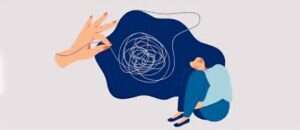Persistent Depressive Disorder (Dysthymic Disorder)

Dysthymia named Persistent Depressive Disorder (PDD), signifies a long-term depression. Feelings of sadness, hopelessness, low mood endure for minimum two years. It’s chronic depression characterized by persisting negative emotions.
What is dysthymic disorder in dsm 5?
In the mental health guide called the DSM-5, dysthymic disorder gets categorized under chronic depressive disorders. It gets identified by prolonged low mood and other symptoms tied to depression. For adults, these symptoms persist for at least two full years. For kids and teens, the time span shrinks to one year minimum. Dysthymic disorder counts as a kind of depressive disorder subtype. People often call it persistent depressive disorder instead.
Dysthymic disorder criteria
Dysthymic disorder also called as Persistent Depressive Disorder (PDD) is recognized when someone feels down most days, more often than not, for two years (one year for kids and teens). They must have at least two signs: appetite or weight changes, sleep troubles, exhaustion, low self-worth, poor focus or indecision, hopeless feelings. Doctors use the DSM-5 manual’s criteria to diagnose. This official book outlines mental disorders.
Persistent Depressive Disorder (Dysthymia) prognosis
Dysthymic disorder can affect everyone differently. While it’s a long-term illness, many find relief through treatment. With help like talk therapy, medication, and lifestyle changes, symptoms become manageable. People may thrive despite the diagnosis when aided early and supported continuously. The outlook varies, but proper care leads to improved well-being.
Misconceptions About Dysthymic Disorder

Persistent Depressive Disorder (Dysthymia) is often misunderstood. Some common beliefs may increase stigma and confusion:
- “It’s Just a Bad Mood”: It is simply feeling blue now and then. However, this disorder involves long-lasting low mood, needing care and proper treatment.
- “You Can Just Snap Out of It”: One can snap out of it with willpower alone. But dysthymia often requires professional help and ongoing support to manage.
- “It’s Not Serious”: Many mistakenly think dysthymic disorder is not serious. Yet, untreated dysthymic disorder impacts daily life and quality. Symptoms may appear mild, but effects can be significant.
- “It’s Just Laziness”: dysthymic disorder is laziness. False! The lack of motivation or energy is a symptom. It requires support, not judgment.
- “It’s Rare”: Some believe dysthymic disorder is rare. However, millions worldwide have this condition. It often goes undiagnosed or untreated due to mental health stigma and misconceptions.
Research and Developments in Persistent Depressive Disorder (Dysthymia)
Dysthymic disorder, known as persistent depressive disorder, seems familiar yet complex. Researchers work tirelessly, aiming to grasp its nuances and develop innovative treatments. Delving into this realm reveals intriguing insights:
-
Brain Scans and Biomarkers: Brain imaging techniques map neural activity patterns, potentially unveiling dysthymic disorder’s neural signatures. Concurrently, biomarker research probes measurable indicators, aiding diagnosis precision and tailored therapies.
-
Genetic Studies: Genetic factors contribute to dysthymic disorder, but the exact cause remains unknown. Scientists study genes, seeking to pinpoint those increasing susceptibility. Understanding genetic influence could guide future treatment.
-
Newer Treatment Options: While antidepressants and therapy remain common treatments, new options like transcranial magnetic stimulation (TMS) offer hope. TMS is a non-invasive brain stimulation technique under research for managing dysthymic disorder symptoms.
Dysthymic disorder va rating
Dysthymic disorder gets evaluated by the VA (Department of Veterans Affairs). The VA uses mental health disorder criteria for rating it. Your rating depends on symptom severity, daily impact. Ratings go from 0% to 100%. Higher ratings mean worse symptoms, greater functional impairment. The VA considers symptom frequency, duration, treatment needs, social functioning impairment, and work issues. These factors determine your dysthymic disorder rating.
How Common is Dysthymia?
Dysthymia is a mood disorder impacting many folks. Research shows approximately 1-3% of grown-ups deal with dysthymia yearly. While that ratio appears tiny, it signifies millions globally grappling with this chronic depressive state. Dysthymia’s relentless presence can profoundly influence one’s well-being over extended periods, warranting compassion and support.
Global Prevalence of Dysthymic Disorder
Dysthymic disorder affects individuals globally. Its prevalence differs across nations, regions. Though more common in certain areas, it presents a significant worldwide mental health issue. Efforts are crucial to raise awareness, diminish stigma, enhance access to mental healthcare services. These initiatives address dysthymic disorder’s global impact.
Dysthymic disorder vs cyclothymic disorder
Dysthymia and cyclothymia are disorders that affect someone’s moods. Moods swing up and down with these conditions, but in different ways. Here’s how they compare:
| Feature | Dysthymic Disorder | Cyclothymic Disorder |
|---|---|---|
| Mood Swings | Primarily Downward | Upward (Hypomanic) and Downward (Depressive) |
| Severity of Mood Swings | Milder (Low Mood) | Milder than Bipolar Disorder, but more extreme than Dysthymia |
| Duration | At least two years of low mood for most of the day | At least one year of alternating hypomanic and depressive periods, lasting for at least a day each (Not serious enough to be labeled as bipolar disorder.) |
| Symptoms During Downward Swings | Similar to Dysthymia: Fatigue, low energy, difficulty concentrating, feelings of hopelessness | Similar to mild depression, but not as severe |
| Symptoms During Upward Swings | Not Present | Increased energy, talkativeness, racing thoughts, feeling overly optimistic or irritable |
| Impact on Life | Can disrupt daily life due to persistent low mood | Can disrupt daily life due to mood swings, but generally less severe than bipolar disorder |
Dysthymia in childhood
Kids and teens undergo dysthymia too. Its main signs match adults’, but minor changes exist. A dysthymic child may seem annoyed, not depressed. Diagnosing dysthymia in youth requires the low mood lasting minimum one year, differing from adult criteria slightly.
What are the differences between major depressive disorder and dysthymic disorder?
